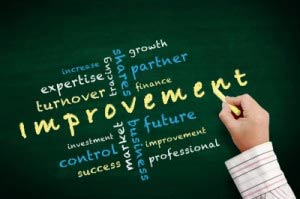
Improving your management skills is a key factor in the success of any business and department. You can’t stand still in today’s business world; to be successful, you not only need to be as good as you possibly can be, you also need to maintain continuous improvement.
So what can you do to maintain this improvement? In what areas can you develop this skill of ‘kaizen’?
Some companies benefit from a systematic approach to continuous improvement set out in a plan. Here are some tips and ideas that will help you:
* Continuous means ongoing, and that means it’s a journey that never ends
* Each year, have a consultant review your business, as they can often see things that you might have missed
* Do the simple things first and quickly. Concentrate on the low-hanging-fruit, building credibility, momentum and commitment
* Do one thing at a time. Design a plan, commit to it and work through it in stages
* Work on the top two or three priorities. This keeps the energy, effort and resources in the right place and doesn’t diffuse the time you spend on it
* When you accomplish results, celebrate. This keeps the motivation high and makes you want to continue with the improvement
* Ensure that any improvements are aimed at increasing the value that you offer to the business’s customers
* Don’t make improvements just for improvement’s sake. Look for breakthrough improvements. You’ll not know the effects and impacts until much later, but they may make a real difference as you maintain continuous improvement
* Try maintaining a continuous improvement culture in everything you do. Don’t just try to copy another company’s ideas or the latest fad or something you read on the net. Let this concept of improvement become that way that you do things every day. It has to become a habit. If it’s just this month’s flavour, it won’t be something that you do regularly and may well end up being a lot of sizzle and no substance
* Look at what your competition may be doing and seek examples of best practice. After testing what they have done and adapted and evolved it to fit your way of working, you develop improvements for your own company that will work specifically for you
By developing a culture that requires sustaining all the time, you help yourself and your team to maintain continuous improvement as a natural way of doing things.

Written by Sean McPheat
CEO of MTD Training and Amazon bestselling author. Sean writes about leadership, business, and personal growth, drawing on 20+ years of experience helping over 9,000 companies improve performance.
Updated on: 28 December, 2012
Related Articles

Search For More 